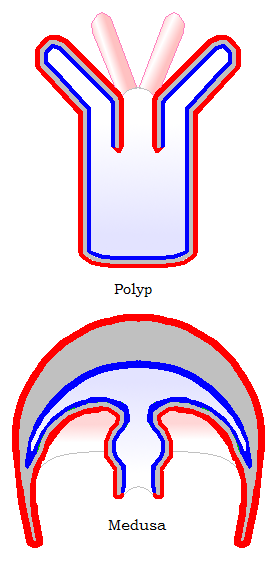Reproduction
The life cycle for Cubozoans is not completely known, although a few hypotheses have been made. This is the most common one I came across in my research. There is an illustrated diagram below.
Wikimedia Commons: Philcha
The Irukandji is dioecious, which means that each organism has a specific
sex: male or female. Therefore, to begin the life cycle, males release haploid
sperm into the water and females release haploid eggs. All Irukandjis do this
simultaneously to allow for a greater chance of fertilization. When an egg is
fertilized it becomes a diploid swimming larva called a planula. The planula
will swim around until it finds a suitable substrate on which to connect itself.
The planula will then form into a young diploid polyp (see image on right). This polyp then undergoes
a metamorphosis and becomes an asexual, diploid, budding polyp colony. During
the polyp phases, the organism will filter feed in order to obtain nutrition.
When mostly developed, extra tentacles used for filter feeding form into lower
parts of the bell, leaving the diploid medusa (see image on right) with just four tentacles when it
pops off the colony. The young medusa will continue to mature and develop until
it releases egg or sperm itself, starting the life cycle all over again. The
life expectancy if not know
for Carukia barnesi.
(Boundless 2013)
Diagram made by Kelsey Lyons
There is much debate whether this is the actual life cycle for Cubozoans. Some scientists argue that only one medusa is formed by a polyp, instead of multiple medusas being produced by a colony. Others are suggesting that internal fertilization (sperm flowing through female mouth and then fertilizing the ova (Grzimek, et. al 2003) or a male physically placing a tentacle with packets of sperm into a female (Marine Education Society of Australasia 2013) ) also occurs.
Next stop: Interactions
UW-L
Last Updated: April 26, 2013






